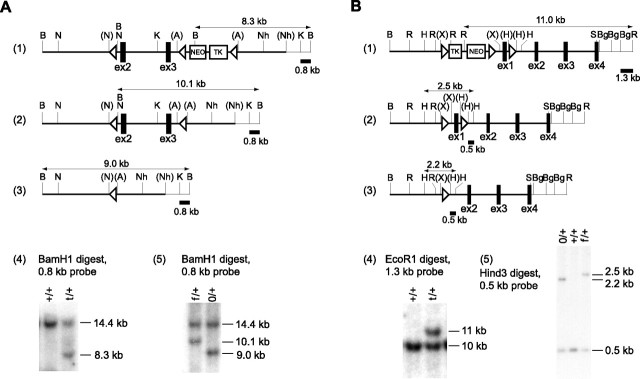Figure 1.
Generation of mice with conditional KO of rap1a and rap1b genes. A, Targeting of rap1a. 1, Targeted locus. 2, Floxed rap1a allele after deletion of the TK-NEO cassette by transient expression of Cre recombinase. 3, The rap1a allele after deletion of coding exons 2 and 3. Rap1a encoding exons 2 and 3 (ex2, ex3), the TK-NEO cassette, and an 0.8 kb BamHI/KpnI fragment used as a probe are shown. BamHI fragments used for identification of mutated rap1a alleles on Southern blot are marked with the horizontal arrows. 4, Southern blot containing DNA from the ES clones after homologous recombination. +/+, WT clone with the WT alleles (14.4 kb); t/+, clone with a targeted rap1a allele (8.3 kb). 5, Southern blot after Cre-mediated excision. f/+, Clone with a floxed allele (10.1 kb); 0/+, clones with a KO allele (9 kb). B, Targeting of rap1b. 1, Targeted locus. 2, Floxed rap1b allele after deletion of the TK-NEO cassette by transient expression of Cre recombinase. 3, The rap1b allele after deletion of the coding exon 1 (ex1). The TK-NEO cassette and 0.5 kb HindIII/HindIII and 1.3 kb BglII/EcoRI fragments used as probes are shown. EcoRI and HindIII fragments used for identification of mutated rap1b alleles on Southern blot are marked with the horizontal arrows. 4, Southern blot containing DNA from the ES clones after homologous recombination. +/+, WT clone with WT alleles (10 kb); t/+, clone with a targeted rap1b allele (11 kb). 5, Southern blot after Cre-mediated excision. 0/+, Clone with the WT (0.5 kb) and KO allele (2.2 kb); +/+, WT contaminating clone; f/+, clone with a floxed allele (2.5 kb). Restriction endonuclease sites ApaI (A), BamHI (B), BglII (Bg), EcoRI (R), HindIII (H), KpnI (K), NcoI (N), NheI (Nh), SalI (S), and XhoI (X) are shown in parentheses when destroyed by cloning. LoxP sites are indicated by triangles. The regions represented with thick lines correspond to the targeting constructs.

